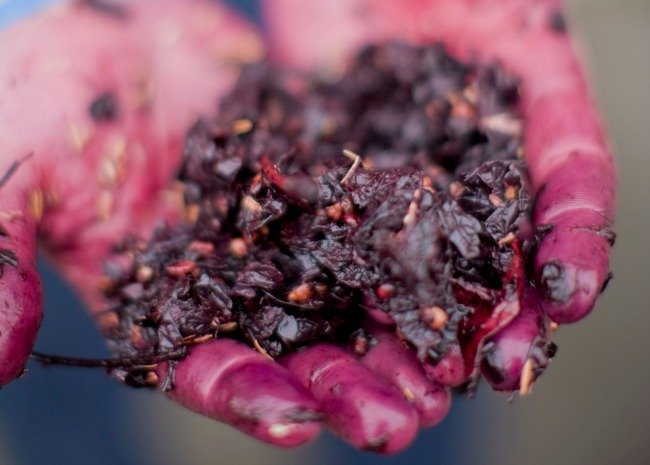How To Make Wine At Home
Have you ever wanted to make homemade wine? Here’s how.

Red wine and carafe | Photo by Meredith
In theory, making wine is very simple. Yeast meets grape juice in an environment that allows fermentation. It’s such a natural process that wine was probably first discovered by happy accident thousands of years ago: Natural yeasts, blowing in the wind, settled down upon a bunch of squashed grapes, whose juice was pooling in the shaded bowl of a rock. After fermenting, some lucky passerby stops and stoops down for a taste…and likes what he discovers.
From there, the process of winemaking will be refined, as you can imagine, and the environment carefully controlled, to the point where winemaking becomes both science and art.
And DIY home winemaking? Well, it probably falls somewhere between the curious stone-age wanderer and the modern vintner who applies artful science to the process.
At any rate, winemaking at home requires several pieces of inexpensive equipment, serious cleanliness, and a mess of patience. Turns out, Tom Petty was right: “The waiting is the hardest part.”
Equipment Checklist:
- One 4-gallon food-grade-quality plastic bucket and lid to serve as the primary fermentation vat
- Three 1-gallon glass jugs to use as secondary fermentation containers
- A funnel that fits into the mouth of the glass bottles
- Three airlocks (fermentation traps)
- A rubber cork (or bung) to fit into the secondary fermentation container
- Large straining bag of nylon mesh
- About 6 feet of clear half-inch plastic tubing
- About 20 wine bottles (you’ll need 5 bottles per gallon of wine)
- Number 9-size, pre-sanitized corks
- Hand corker (ask about renting these from the wine supply store)
- A Hydrometer to measure sugar levels
Ingredient Checklist:
- Lots and lots of wine grapes
- Granulated sugar
- Filtered water
- Wine yeast
To the above basic list you can refine the process by adding such things as Campden tablets to help prevent oxidation, yeast nutrients, enzymes, tannins, acids, and other fancy ingredients to better control your wine production.
Making Wine
Part 1
- Ensure your equipment is thoroughly sterilized and then rinsed clean. (Ask at the wine supply store about special detergents, bleaches, etc.). It’s best to clean and rinse your equipment immediately before using.
- Select your grapes, tossing out rotten or peculiar-looking grapes.
- Wash your grapes thoroughly.
- Remove the stems.
- Crush the grapes to release the juice (called “must”) into the primary fermentation container. Your hands will work here as well as anything. Or go old school and stomp with your feet. If you’re making a lot of wine, you might look into renting a fruit press from a wine supply store.
- Add wine yeast.
- Insert the hydrometer into the must. If it reads less than 1.010, consider adding sugar. If you’re adding sugar, first dissolve granulated sugar in pure filtered water (adding sugar helps boost low alcohol levels). Stir the must thoroughly.
- Cover primary fermentation bucket with cloth; allow must to ferment for one week to 10 days. Over the course of days, fermentation will cause a froth to develop on top and sediment to fall to the bottom.

Making Grape Juice | Photo by Meredith
Part 2
- Gently strain the liquid to remove the sediment and froth.
- Run the juice through a funnel into sanitized glass secondary fermentation containers. Fill to the top to reduce the amount of air reaching the wine.
- Fit the containers with airlocks.
- Allow the juice to ferment for several weeks.
- Use the plastic tube to siphon the wine into clean glass secondary fermentation containers. Again, the purpose here is to separate the wine from sediment that forms as the wine ferments.
- Continue to siphon the wine off the sediment periodically (this is called “racking”) for 2 or 3 months until the wine is running clear.
Part 3
- Run the wine into bottles (using the cleaned plastic tubing), leaving space for the cork plus about a half inch or so of extra room.
- Insert corks.
- Store the wine upright for the first three days.
- After three days, store the wine on its side at, ideally, 55 degrees F. For red wine, age for at least 1 year. White wine can be ready to drink after only 6 months.
Enjoy!

Blues Brother Wine Dinner
Wine Recipes
Here’s a recipe for making wine that calls for frozen juice concentrate — and another that turns pesky dandelions into a tasty beverage.
- Homemade Wine
- Dandelion Wine
Did You Know? Back in the days of prohibition, when wine was illegal to produce, grape growers would mail blocks of grapes to thirsty patrons, along with packets of yeast and careful directions on how to prevent the two ingredients from accidentally coming together and turning into wine.